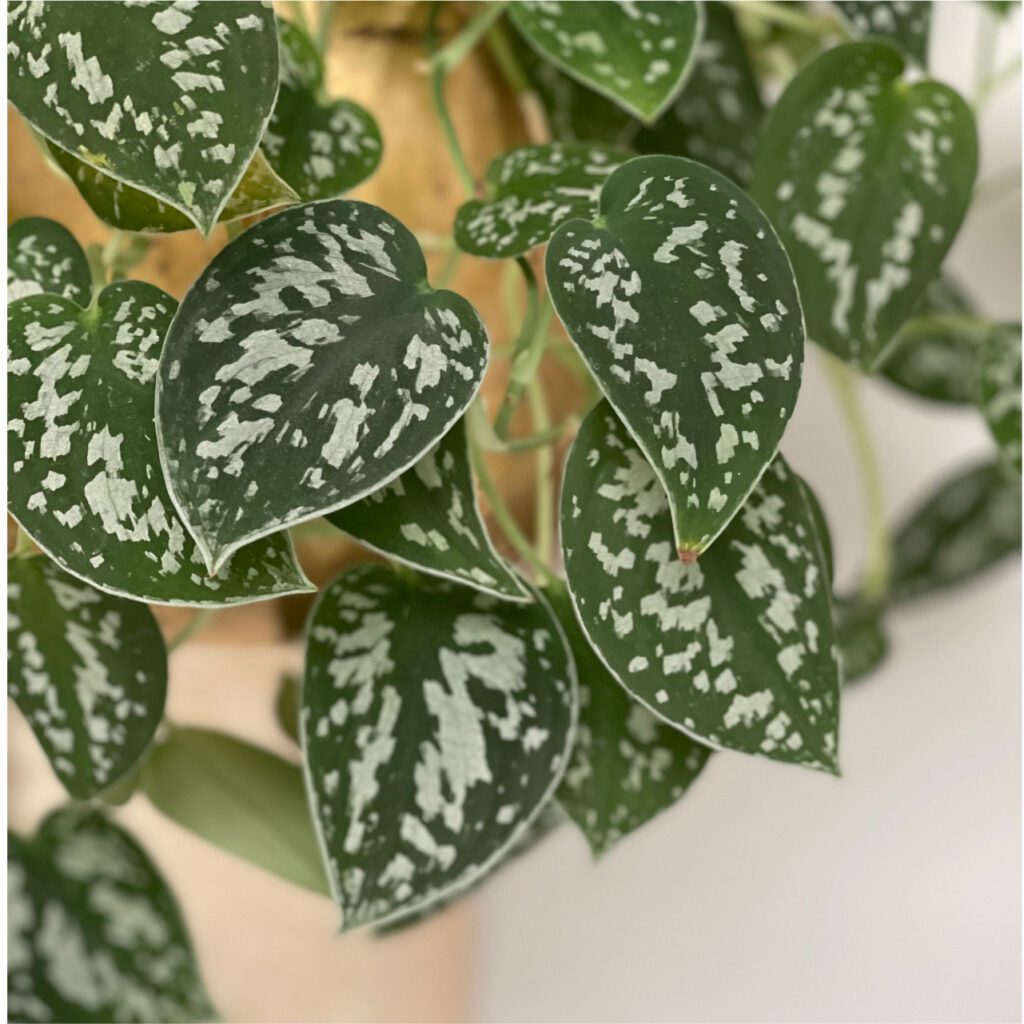Pothos is one of the most popular indoor plants available due to its easy care requirements, forgiving nature, and beautiful foliage. There are many different varieties of pothos, but which one is right for you?
In this blog post, we will discuss the top 12 pothos varieties and their characteristics. Whether you are looking for a plant with brightly-colored leaves or one that has a more subdued appearance, there is sure to be a pothos variety that fits your needs!
The top 12 varieties of “Pothos” are
- Golden pothos
- Marble queen pothos
- Neon pothos
- Manjula pothos
- Cebu blue pothos
- Jessenia pothos
- Hawaiian pothos
- Scindapsus Treubii Moonlight pothos
- Baltic Blue pothos
- N-Joy pothos
- Satin pothos (or silver pothos)
- Pearls and jade pothos
Pothos, Epipremnum, Scindapsus Pictus, so many aliases for this common indoor plant
Pothos plants are one of the most popular houseplants around, and it’s easy to see why. They’re easy to care for, they can tolerate a wide range of growing conditions, and they’re lovely plants. If you’re thinking about adding a pothos plant to your home, here’s what you need to know about their care and requirements.
Pothos plants are native to tropical regions, so they prefer warm, humid conditions. They’ll do fine in most homes, however, as long as they’re not in a drafty spot or in harsh direct sunlight. These plants are tolerant of drought, so if you forget to water them for a few weeks, they’ll likely survive. When watering, give them enough to keep the soil moist but not soggy.
Pothos plants are relatively low-maintenance when it comes to fertilizer, but they will benefit from being fed every few months during the growing season. A balanced liquid fertilizer is all you need; be sure to follow the directions on the package. As for the potting mix, any good-quality potting soil will do. Just be sure that it drains well to avoid root rot.
Pothos plants are very easy to propagate from stem cuttings. Simply take a cutting from an existing plant and root it in water or a moist potting mix. In no time at all, you’ll have a brand-new plant!
See my article on How to Propagate Plants Like a Pro
Are pothos plants poisonous?
Yes, they are toxic to people, and pets if ingested. While they aren’t typically deadly, pothos plants have insoluble calcium oxalate crystals within their leaves and stems. These crystals can cause harm if ingested. Also while they are extremely abrasive, they are not toxic to touch.
So there you have it, everything you need to know about pothos plant care. With just a little bit of effort, you can easily keep these beautiful indoor plants healthy and happy for many years to come.
The top 12 varieties in detail:
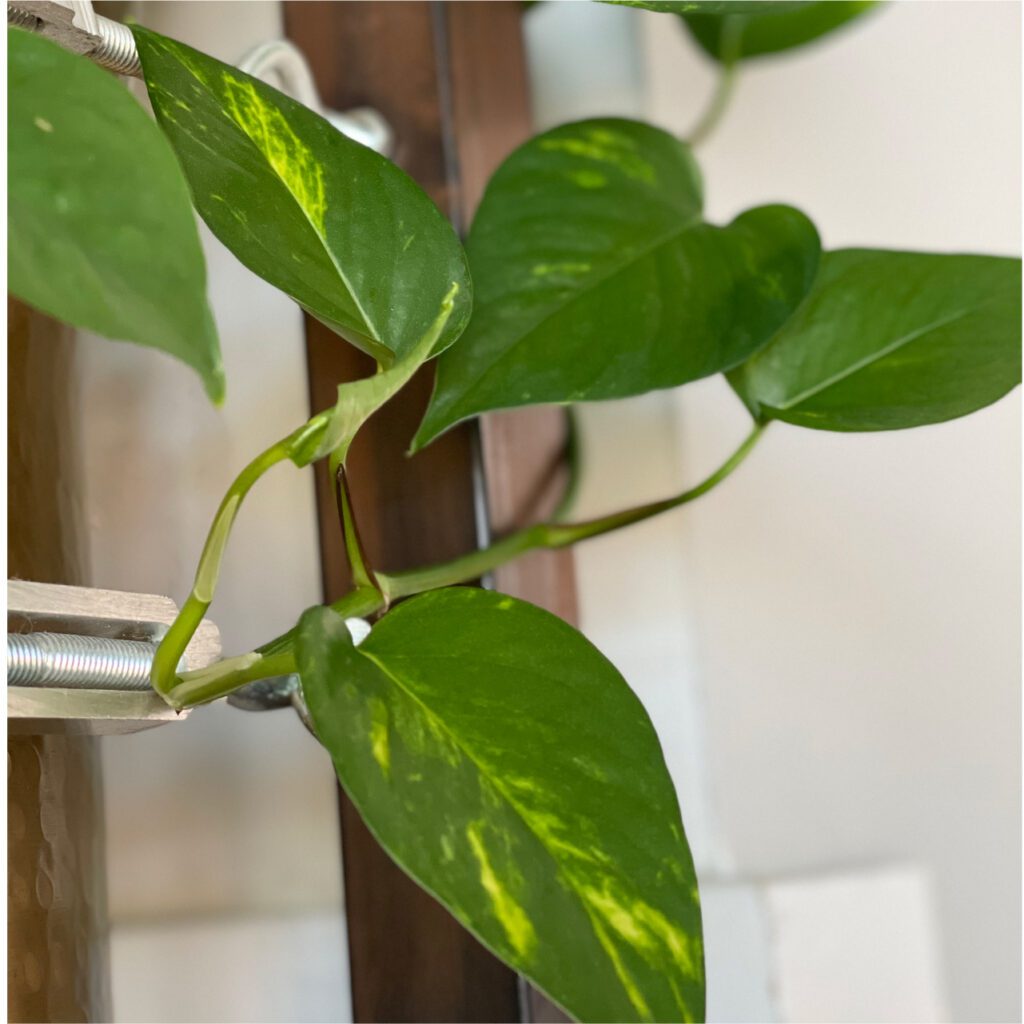

Golden pothos:
Golden pothos (Epipremnum aureum) is a beautiful, easy-to-care-for houseplant that can brighten up any indoor space. Also known as “devil’s ivy,” golden pothos is a trailing or climbing vine that is native to Southeast Asia. It is an evergreen plant with heart-shaped leaves that are variegated with shades of yellow, green, and white.
The Golden pothos is a low-maintenance plant that can thrive in a wide range of conditions. It is an ideal plant for beginners, as it is very forgiving if you forget to water it or give it too much sunlight. Golden pothos is also known for its ability to purify the air of harmful toxins, making it a healthy choice for your home or office. If you are looking for a beautiful and easy-to-care-for houseplant, golden pothos is a perfect choice!
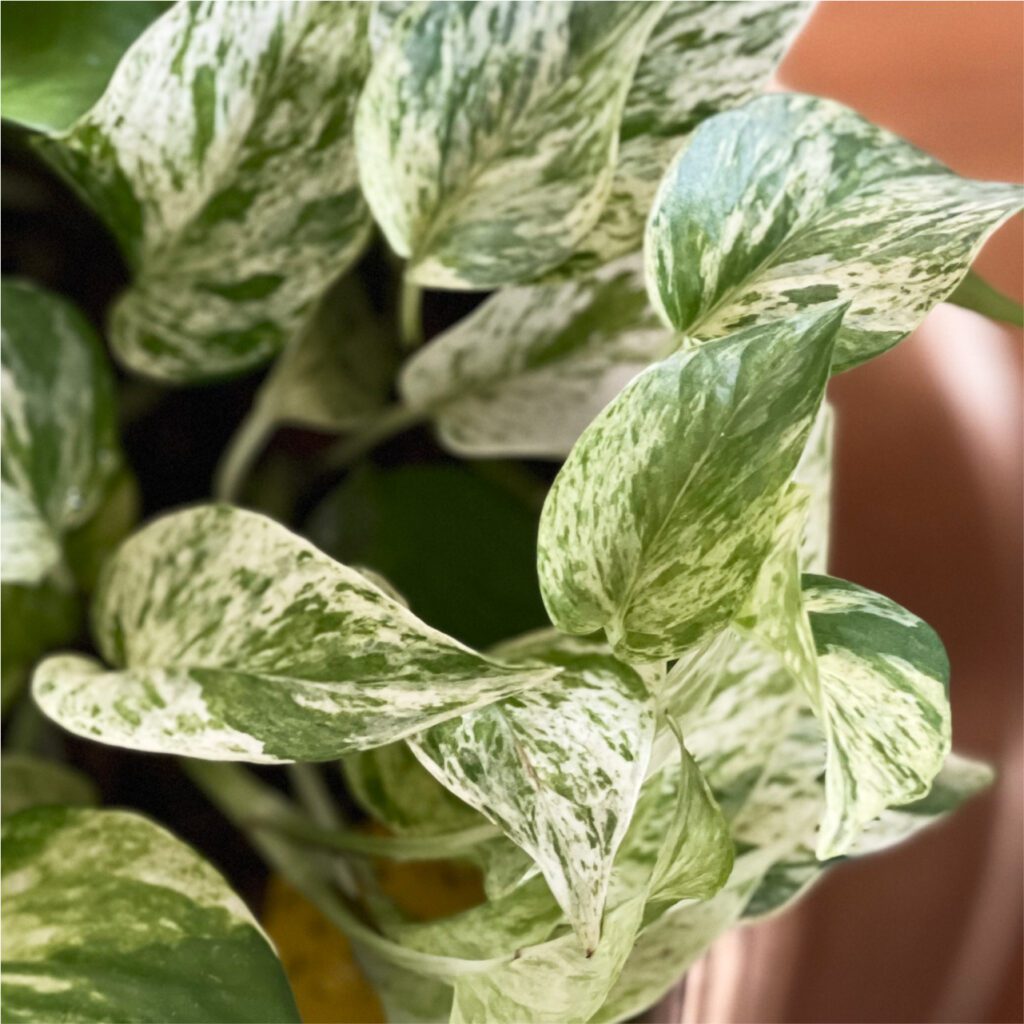

Marble queen pothos:
The marble queen pothos (Epipremnum aureum “Marble Queen”) is a beautiful and easy-to-care-for houseplant that can brighten up any space. This variety is native to French Polynesia.
The plant gets its common name from its marbled leaves, which are a deep green with splashes of white or cream. The marble queen pothos is a hardy plant that can tolerate low light and somewhat poor soil conditions. It is also semi-resistant to drought, making it an ideal choice for those who forget to water.
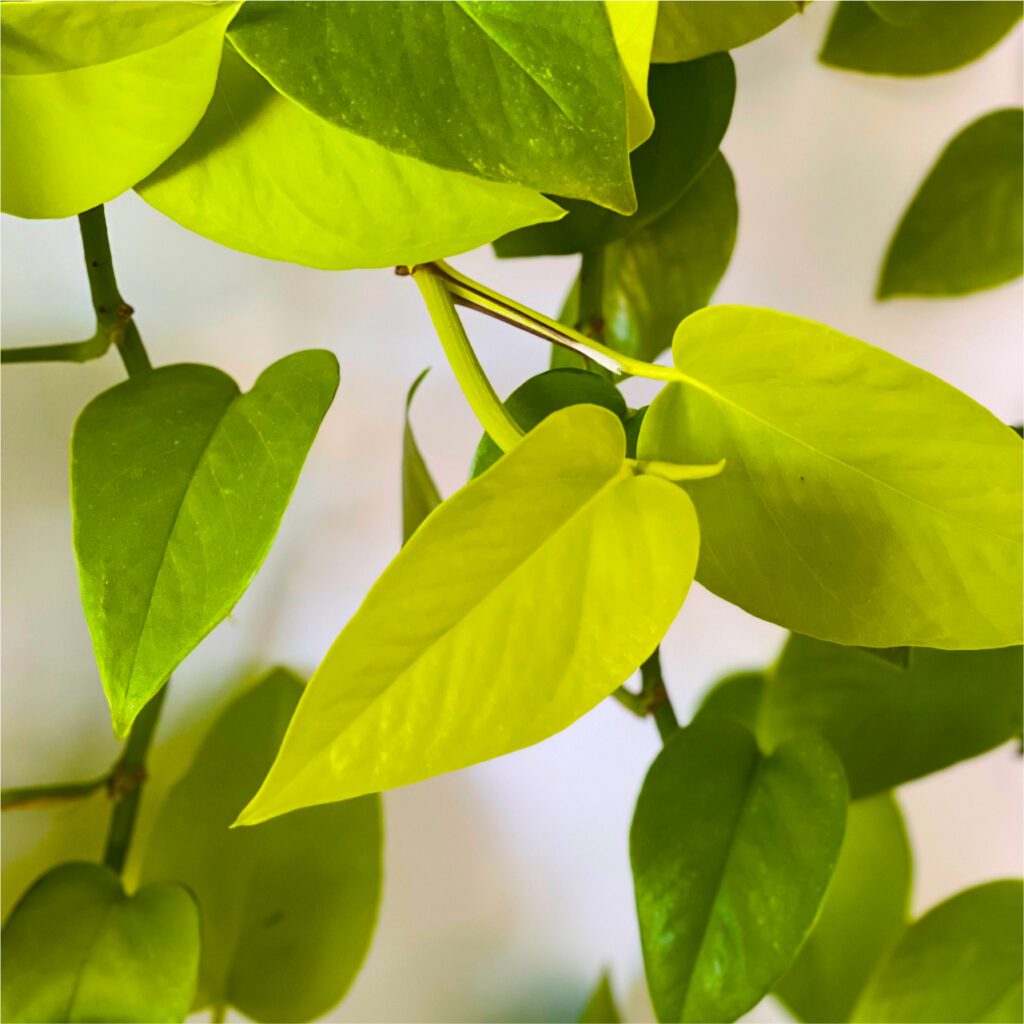

Neon pothos:
The Neon pothos (Epipremnum aureum ‘Neon’) is native to French Polynesia and is a popular houseplant known for its extremely vibrant foliage. The heart-shaped leaves sometimes have slight variegation and can grow to about 6 inches long. Neon pothos is an easy plant to care for, and it will thrive in just about any type of potting mix. It prefers bright indirect light but can tolerate lower light levels. Water when the top inch of soil becomes dry, and fertilize monthly during the growing season. Neon pothos is a fast-growing plant, so you may need to re-pot it every year or so. With proper care, your Neon pothos will continue to brighten up your home for years to come!
Manjula pothos:
Manjula pothos (Epipremnum aureum ‘Manjula’) is a fast-growing, trailing vine that seems to be native to a laboratory in Inda. It is a member of the Araceae family and is closely related to philodendrons and anthuriums. The plant gets its common name from its ovate, dark green leaves, which are similar in shape to those of the pothos (Epipremnum aureum).
Manjula pothos is a vigorous climber that can reach up to 20 feet in length. It prefers warm, humid conditions and can be grown indoors or outdoors in USDA hardiness zones 10-12. The plant is tolerant of low light levels and can even thrive in artificial lighting. When grown indoors, Manjula pothos will prefer a bright spot near a window.
Outdoors, it can be grown in partial shade or full sun. Manjula pothos is not frost-tolerant and should be brought indoors when temperatures start to drop in the fall. The plant can be propagated by stem cuttings or by division. It is not susceptible to pests or diseases but can be affected by mealybugs and spider mites. Manjula pothos is an easy-to-care-for plant that makes an excellent choice for beginner gardeners. With its tolerance for low light levels and its ability to thrive in artificial lighting, it is also a good option for indoor gardeners.
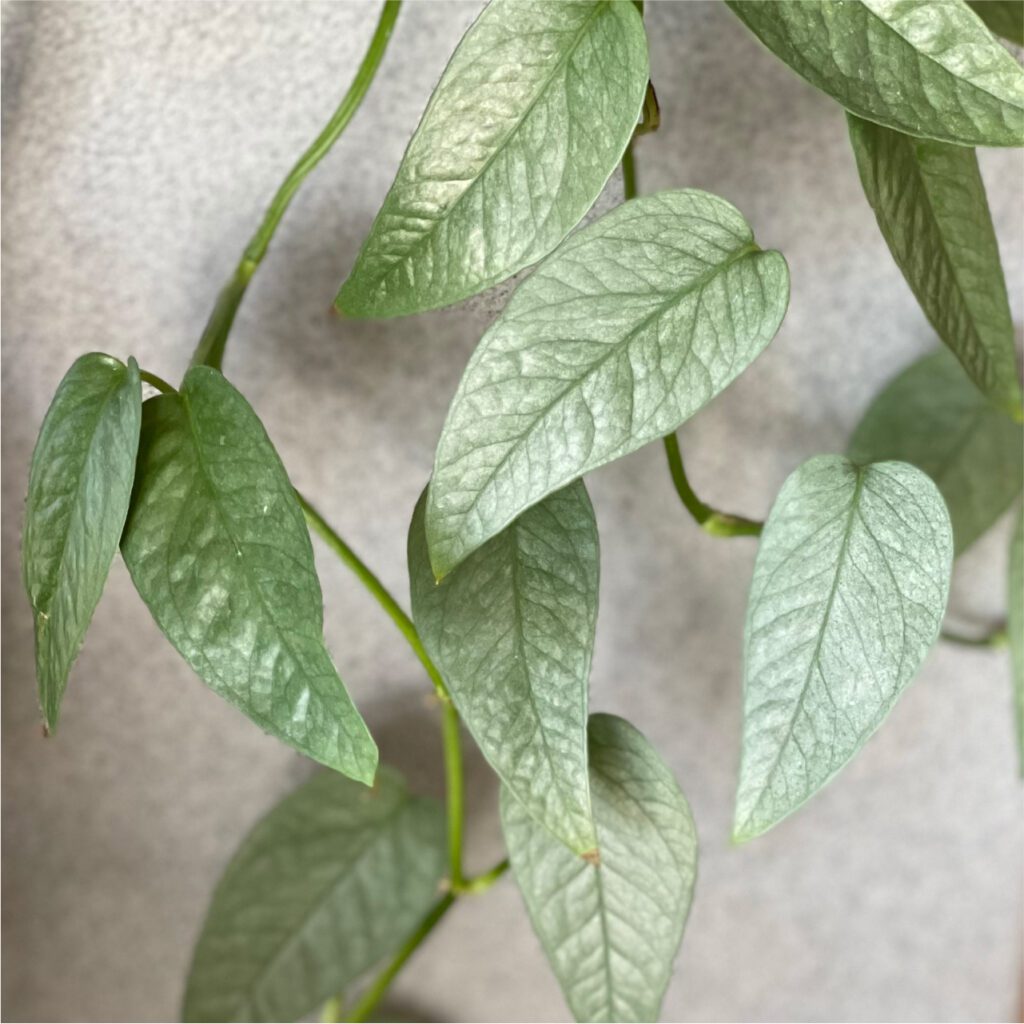

Cebu blue pothos:
The Cebu blue pothos plant (Epipremnum Pinnatum) is an evergreen climber from Cebu island in the Philippines. It has bright, silvery, blue-green leaves in an elongated heart shape that can grow 6-8 inches in length. The leaves are attached to stout stems that can reach up to 20 feet in length. This plant is fast-growing and easy to care for, making it a popular choice for both indoor and outdoor gardens. Cebu blue pothos does best in partial shade, but can also tolerate full sun and partial shade. It is drought-tolerant and does not require much fertilizer. However, it does need regular watering during the growing season. This plant is susceptible to mealybugs and spider mites, so it is important to inspect it regularly for pests. Cebu blue pothos makes an excellent houseplant or groundcover in tropical gardens.
Jessenia pothos:
The Jessenia pothos (Epipremnum aureum ‘Jessenia) is native to tropical rainforests in Central and South America. Jessenia pothos is a beautiful evergreen vine that can grow up to 30 feet long. Its heart-shaped leaves are deep green in color and have a glossy sheen. The vine produces small, greenish-white flowers that bloom in summer. Jessenia pothos is a popular houseplant because it is very easy to care for. It prefers bright, indirect light but can tolerate low-light conditions. The vine is also very tolerant of drought conditions and can go several weeks without water. When watering, allow the soil to dry out completely between watering. If you’re looking for a fast-growing plant that is also low-maintenance, Jessenia pothos is a perfect choice!
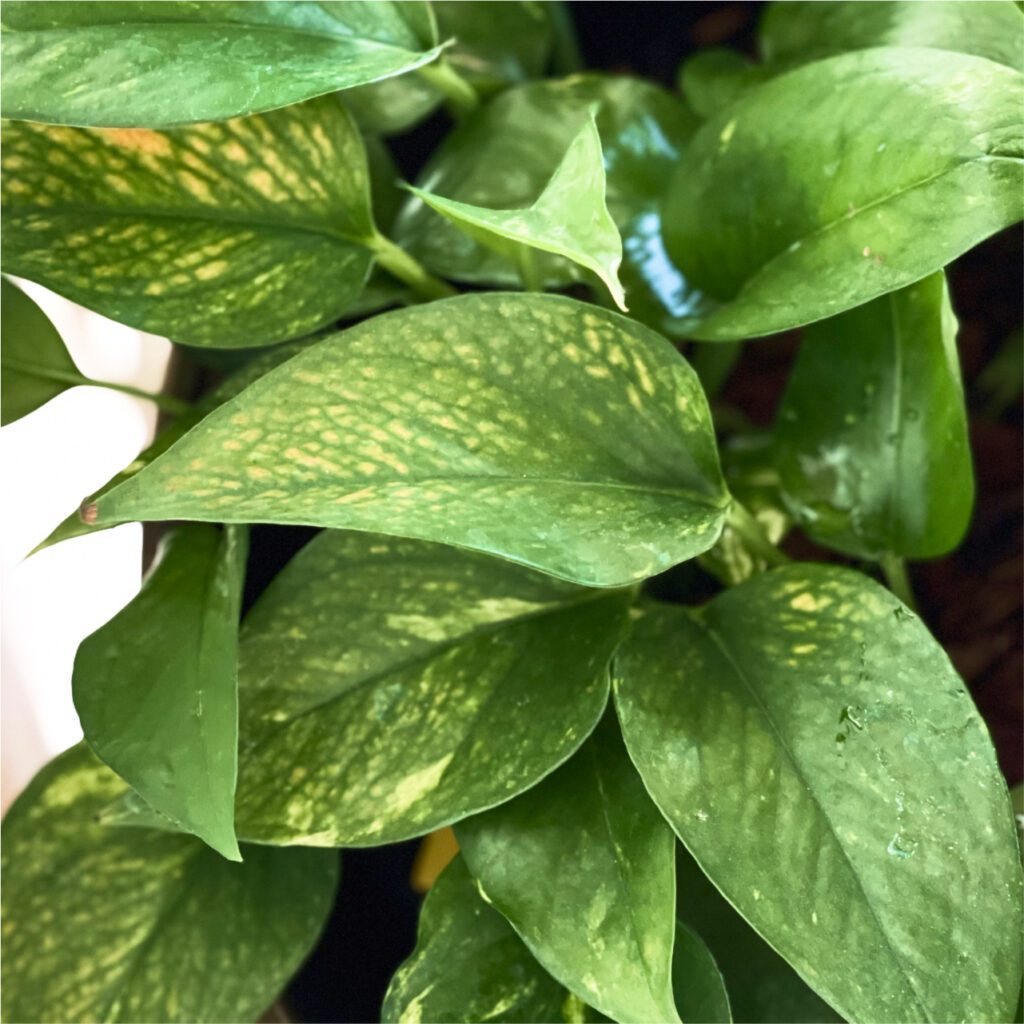

Hawaiian pothos:
The Hawaiian pothos (Epipremnum aureum) is a beautiful indoor houseplant that is relatively easy to care for. Also called “Devil’s Ivy,” it is native to the Solomon Islands but has become widely popular in Hawaii. The plant gets its name from its heart-shaped leaves, which are typically variegated with green and white stripes. Hawaiian pothos is a vigorous grower and can quickly become pot-bound, so be sure to re-pot it every year or two. The plant prefers bright, indirect light but can tolerate low light levels. It is drought-tolerant and does not require frequent watering; in fact, overwatering can cause the leaves to turn yellow and drop off. Hawaiian pothos is mildly toxic to pets and children, so be sure to keep it out of reach. With its beautiful variegated leaves, Hawaiian pothos is a stunning addition to any home.
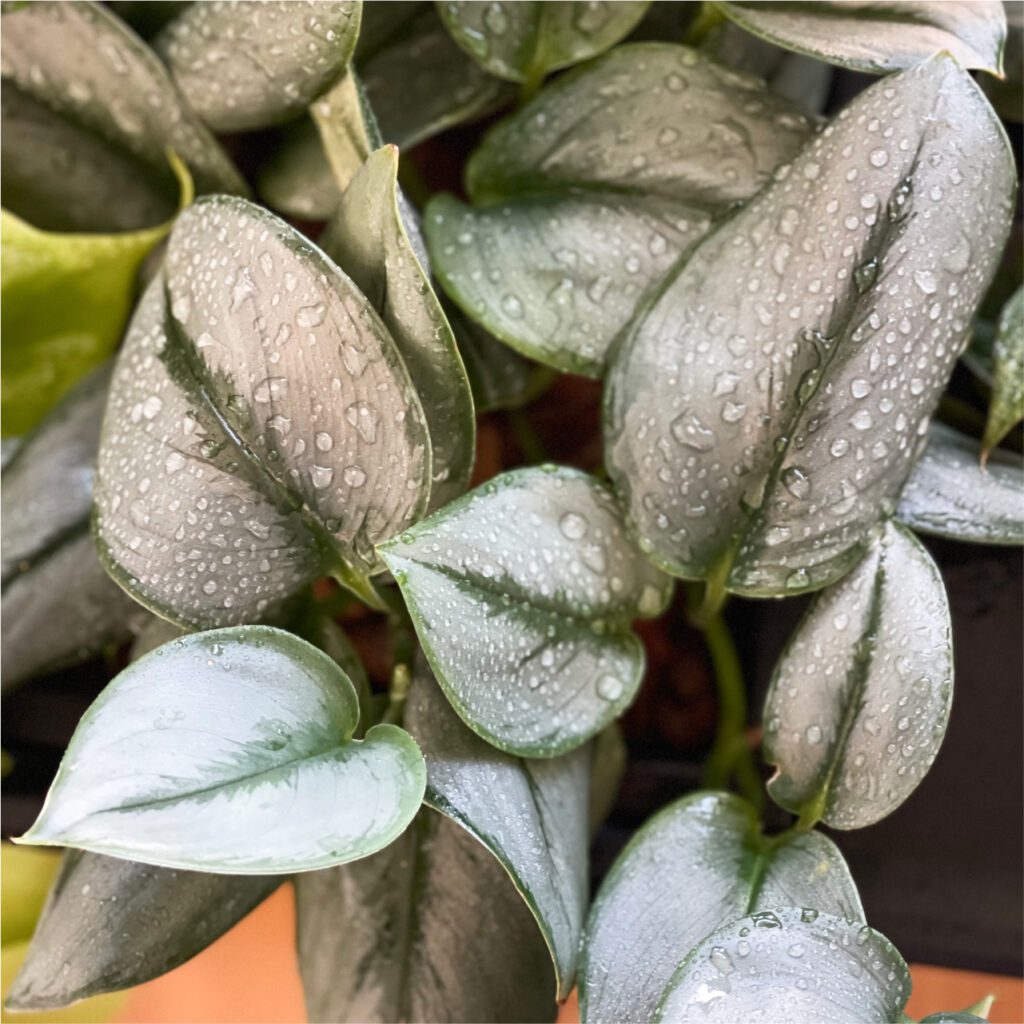

Scindapsus Treubii Moonlight pothos:
The Scindapsus Treubii Moonlight is not an actual pothos but is commonly sold as one. This stunning slow growing plant is native to South-East Asia. It is a climbing vine that can grow up to 20 feet in length. The leaves of the plant are heart-shaped and dark green with a silver sheen. The flowers of the plant are white and they bloom in the summertime. The Scindapsus Treubii Moonlight “Pothos” is an easy plant to care for and it is tolerant of low light conditions. The plant does best in soil that is allowed to dry out in between waterings. The plant does not like to be overwatered and it should be fertilized every two weeks during the growing season. The Scindapsus Treubii Moonlight is a beautiful plant that can add some pizzazz to any home or office.
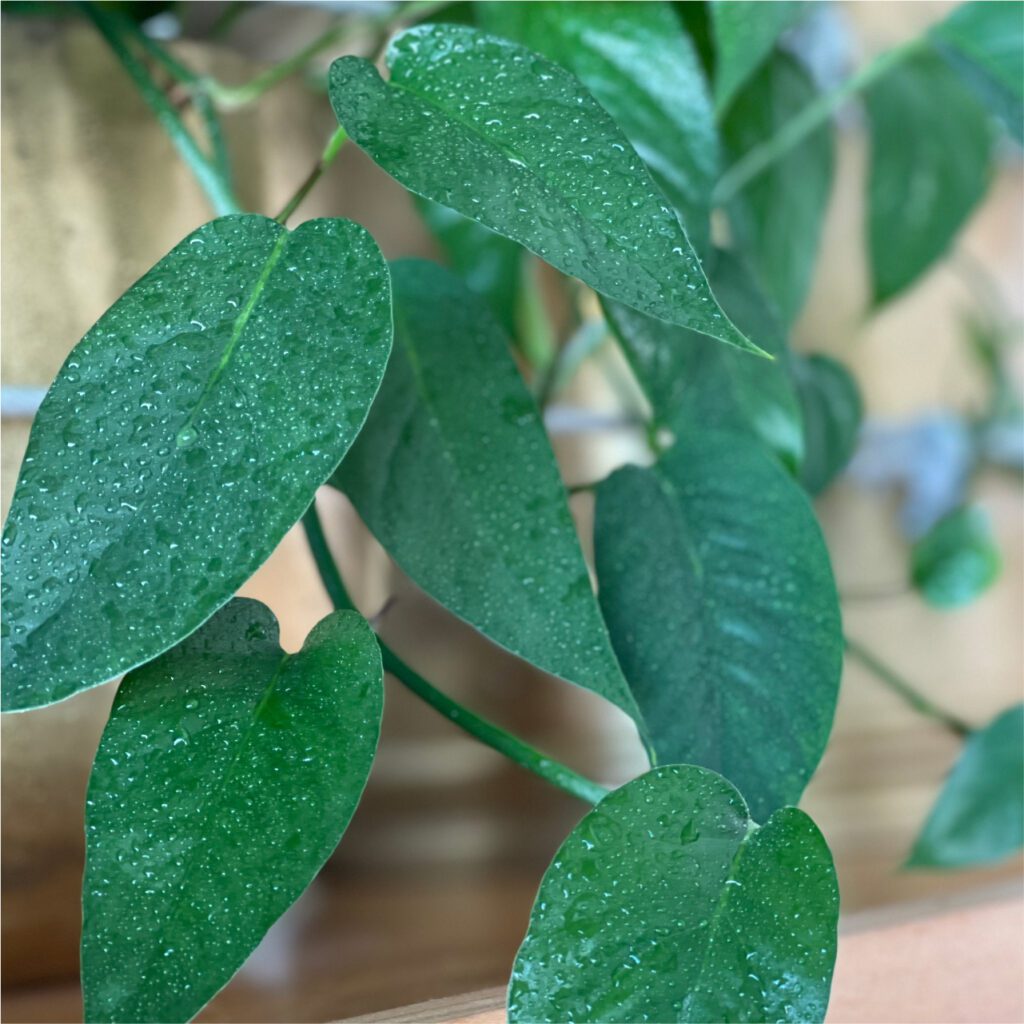

Baltic Blue pothos:
The Baltic Blue pothos (Epipremnum Pinnatum) was allegedly discovered by Costa Farms in 2022. It is believed to be a mutation from the natural dark green Epipremnum pinnatum.
Baltic blue and Cebu Blue are both Epipremnum Pinnatum, but Cebu blue has a lighter silver blue color. The leaves of Baltic Blue Pothos aren’t as bluish-green and don’t have the same silver shine. The leaves of Baltic Blue are more a of rich saturated blueish green color.
One of the best attributes of baltic blue is that they will develop fenestrated leaves sooner than other pothos varieties. Easy to care for and tolerant of low light conditions, it is an ideal houseplant for beginners. However, this plant can also be finicky when it comes down to its watering needs. So it’s important to keep an eye on the soil moisture level and never allow the roots to become soggy. If you’re looking for a bit of variety in your indoor jungle, consider adding Baltic Blue to the mix.


N-Joy pothos:
The N-Joy pothos (Epipremnum aureum) is a beautiful houseplant that is easy to care for and thrives indoors. The plant has dark green leaves with white variegation that looks stunning in any home. The N-Joy pothos is a fast-growing plant and can reach up to six feet in length. It is an excellent plant for beginners as it is very forgiving and can tolerate a wide range of conditions.
The N-Joy pothos is a cultivator of the popular marble queen pothos. This variety has smaller, thinner leaves with more pronounced areas of variegation than the marble queen. It is rumored that it was discovered by the University of Florida back in 2002.
To care for the N-Joy pothos, water when the soil is dry and fertilize monthly during the growing season. The plant can be propagated easily from stem cuttings, so it is easy to share with friends or start new plants. The N-Joy pothos is a beautiful addition to any home and makes an excellent gift for plant lovers.
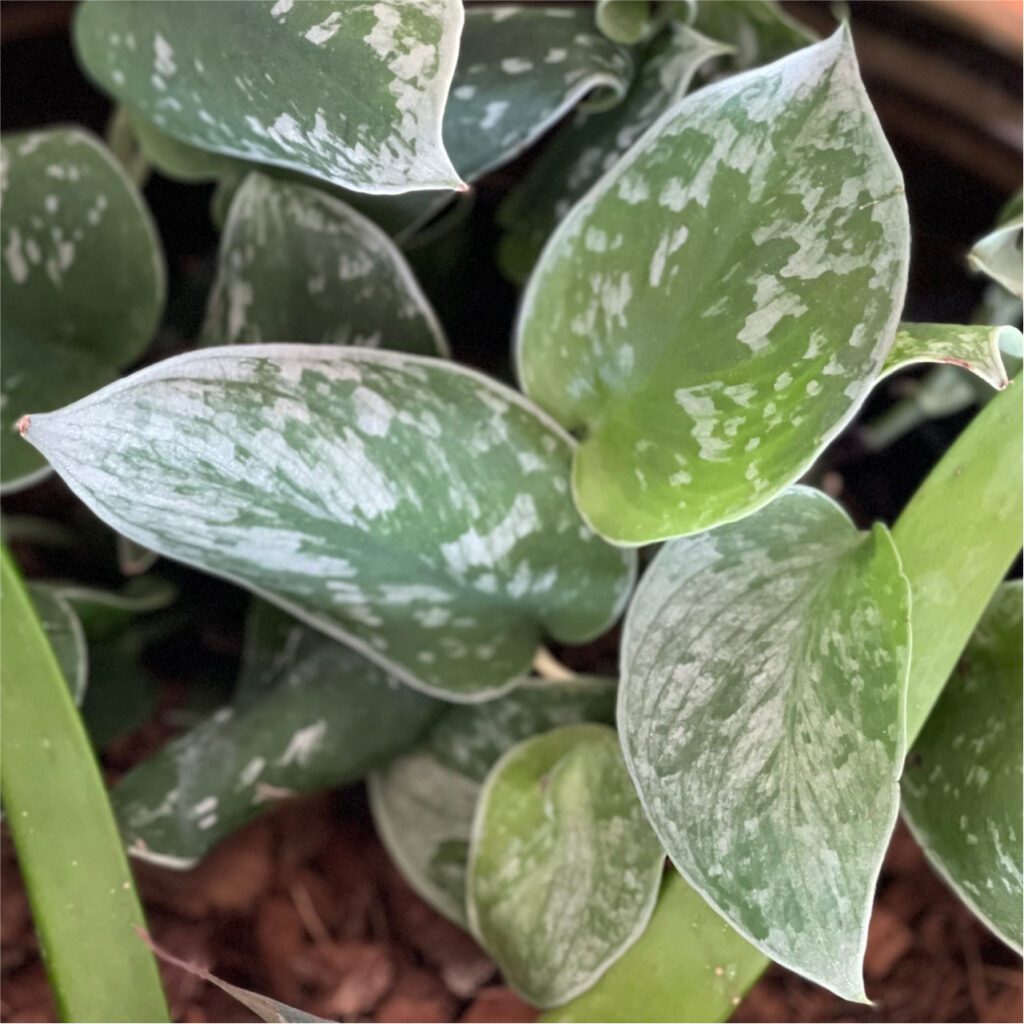

Satin pothos (or silver pothos):
The satin pothos (Scindapsus pictus), also known as the silver pothos, is a beautiful and versatile houseplant. This plant is closely related to Pothos (Epipremnum aureum) but with leaves that are variegated with silver and green.
The satin pothos is a fast-growing plant that can reach up to six feet in length, making it an ideal choice for hanging baskets or trailing over shelves and tables. While the satin pothos is easy to care for, it does require some basic knowledge to keep it looking its best.
The satin pothos prefers bright, indirect light but can also tolerate low-light conditions. If the leaves start to turn yellow, this is a sign that the plant is not getting enough light. Water when the top inch of soil feels dry to the touch. Allow the soil to dry out completely between waterings to prevent root rot. Overwatering is the most common cause of death for this plant.
To maintain a healthy satin pothos, feed monthly during the growing season with a balanced liquid fertilizer diluted by half. Reduce fertilizer during the winter months when growth slows down. Prune back overgrown stems as necessary to maintain the desired shape of your plant. Any stems that are brown or dying can also be removed.
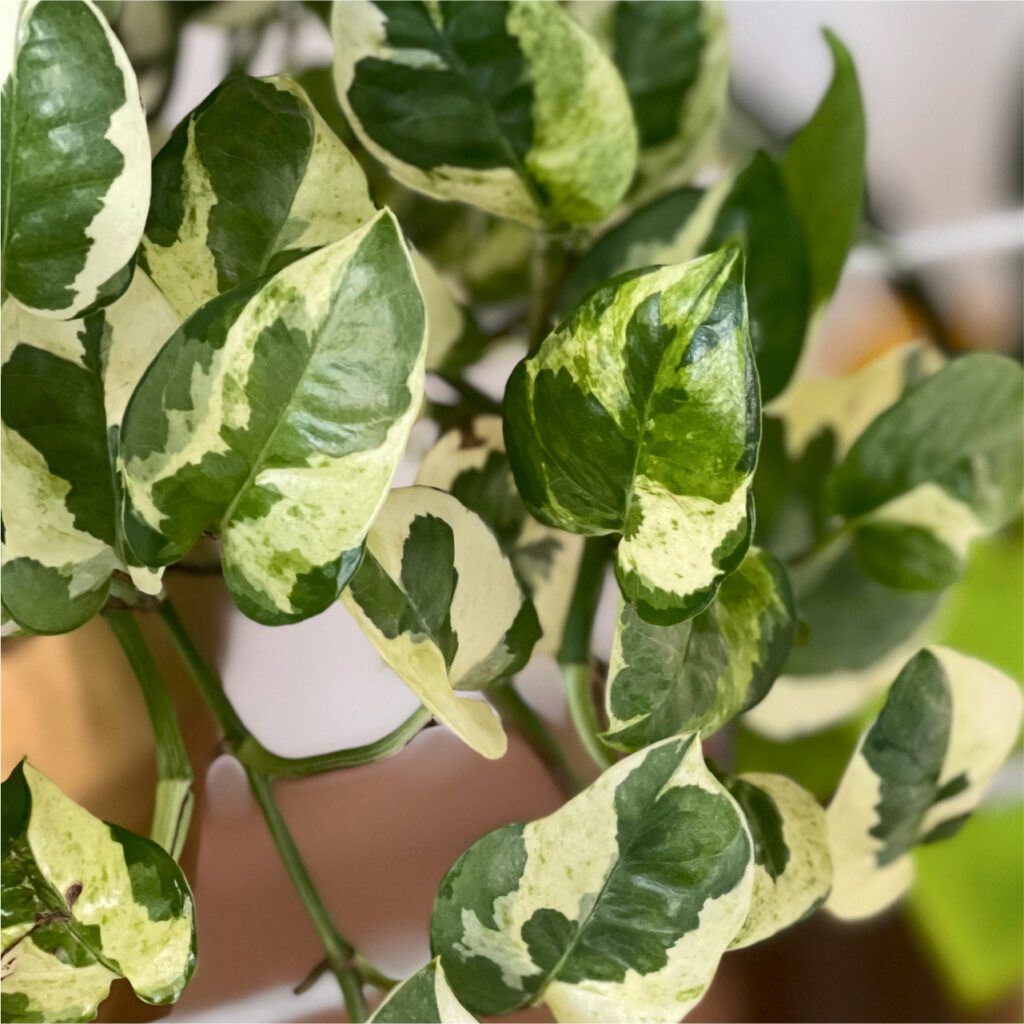

Pearls and jade pothos:
Pearls and jade pothos (Epipremnum aureum) is extremely similar to N-Joy pothos and is also a cultivator of marble queen pothos. This variety has the same small, thinner leaves with more blotchy colors in its variegation than N Joy.
To care for the Pearls and jade, water when the soil is dry and fertilize monthly during the growing season. The plant can be propagated easily from stem cuttings, so it is easy to share with friends or start new plants. The N-Joy pothos is a beautiful addition to any home and makes an excellent gift for plant lovers.
I hope you have enjoyed my article on all that is Pothos
As highlighted in this article, the pothos plants come in so many varieties, some common, some not. Some are green, green with yellow, green with white, silver-blue dark, bluish-green, or even lemon lime! With all these choices I am sure you will fall in love with this easy-to-care-for plant commonly known as Pothos!
